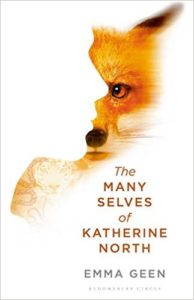
By Jonathan McCalmont
The Many Selves of Katherine North — Emma Geen (Bloomsbury)
*
 I entered 2016 with my affection for science fiction at a low ebb. My levels of engagement with the genre have varied quite considerably with the passage of time but I was suddenly aware that I had been writing about science fiction for over a decade and that said decade had left my tastes almost completely estranged from those catered to by the larger genre imprints.
I entered 2016 with my affection for science fiction at a low ebb. My levels of engagement with the genre have varied quite considerably with the passage of time but I was suddenly aware that I had been writing about science fiction for over a decade and that said decade had left my tastes almost completely estranged from those catered to by the larger genre imprints.
To make matters worse, a period of aesthetic retrenchment engendered by financial crisis and structural changes in the book-selling market has coincided with a cultural panic over far-right entryism resulting in virtually all of genre culture turning its attention to a narrow range of hyper-commercial forms. In today’s genre marketplace, it feels as though you can read books by a wide array of different authors just so long as you are content to read epic fantasies, urban fantasies, or space operas. A decade ago, I probably would not have noticed the effects of the aesthetic retrenchment but the current round of belt-tightening has come at precisely the time when I find myself wanting to read something completely different…
If I had to list the books that have inspired my current genre preferences I would, without hesitation, point to Adam Roberts’ New Model Army, Nina Allan’s The Race, Simon Ings’ Wolves, and Tom McCarthy’s Satin Island. All of these novels are set in recognisable places that are made to seem ever-more alien by the dance of technology and its neoliberal bassline. I would never argue that these books represent the only viable form of science fiction, nor would I argue that they are somehow ‘more science-fictional’ than books containing spaceships or wizards. These books are inherently neither better nor worse than any other form of science fiction but they form an aesthetic that speaks to me personally and I wish that there was more of it floating about. Most of the columns I wrote last year for the magazine Interzone were inspired by the quest for more of this-kind-of-thing and those aesthetics also inspired my personal shortlist for this project.
Emma Geen’s debut novel The Many Selves of Katherine North was the fourth book I looked at in my quest for something different and I think it marked the point where I became fully aware of the kinds of books that I really want to read. This was extraordinarily exciting. The book is set in a recognisable – British as it turns out – place that has been left more-or-less unscathed by the march of technology but its protagonist is a fantastic example of a subjectivity that is born to this moment and torn to shreds by technological change. Upon re-reading The Many Selves of Katherine North, I became more aware of the book’s flaws but it remains a beautifully-written science fiction novel that speaks of a world that seems to become ever-more intolerable while the technological escape hatches we create for ourselves only ever seem to make matters worse.
Like many of the better books to emerge last year, The Many Selves of Katherine North is a novel made up of a series of discrete parts that require both a squint and a leap of the imagination before they fall into conventional narrative order. The spine of the book is provided by a series of set-pieces in which the book’s protagonist is projected into the mind of different animals and forced to contend not only with their alien cognitive processes but also with their (occasionally overwhelming) instincts to run, jump, fly, hunt, eat, and even fuck. Extensively researched and beautifully rendered, all of these set-pieces are powerfully imagined and beautifully written almost to the point where they overwhelm the novel. And therein lays the point…
Beneath the animal-projections and unconventional structures is a story about a young girl who has deliberately allowed her-‘self’ to get lost. Hired at a young age by a then-fledgling research company, Katherine — sometimes “Kathy”, sometimes “Kit”, and sometimes “North” – spends her days being projected into the minds of endangered animals in the hope that her experiences ‘being’ different creatures will allow scientists to learn more about both the creatures’ instincts and their fragile cohabitations with man. The book begins with Katherine inhabiting the body of an urban fox to whose world she has become enormously attached. These moments are as close as Katherine gets to being happy in the novel but the happiness is wrenched from her when an unexpected encounter with a van kills her animal body and so terminates her connection to a fox cub known as Tomoko. Unfortunately, the van also turns out to be the straw that breaks the fox’s back as the trauma of the accident sets Katherine on a course that endangers first her employment and then her sanity.
“I press my face into my knees. Everything feels unreal, as if this were a Ressy with the haptic inputs tuned down. I try to imagine the rest of my life like this, living on the fringes; mind decomposing as the words dissolve into the roar of being. It doesn’t matter that I’ve spent seven years as other animals, there was always a human thread to tether me: science, Buckley, purpose. I don’t know what it is to live day by day, existing just to exist. For something so vacuous, the future has monstrous weight.”
At first, Katherine’s problems seem to be the results of the accident: She struggles to make sense of the humans surrounding her, she reverts to animal behaviour in stress situations, and she keeps returning to her old vulpine hunting grounds just managing to stop short of eating out of the bins. Then the novel raises the possibility that her problems re-integrating human life might be a product of the declining neuroplasticity that is the fate of all human adults. Geen handles this misdirection quite skilfully, littering Katherine’s animal interludes with images and ideas that hint at a deeper and more pervasive human problem.
Things get even worse when the director of the research company announces his decision to use Katherine not only as the face of their latest PR blitz but also as guide for a group of wealthy tourists who are paying for their chance to experience life as the animal of their choice. This aspect of the book is easily misread as Katherine reacts to the admittedly drastic changes in her terms of employment by escaping into a warren of conspiracy theories designed to make narrative sense of an adult world. While an employee who was more ‘present’ and emotionally stable might have realised that she was effectively in a position to write her own cheque and set her own terms of employment, a traumatised Katherine becomes convinced that her being moved into another job is part of some scheme to force her out of the company. Rather than making her feelings clear, Katherine sulks and throws tantrums until even her closest friends begin to get frustrated with her behaviour.
Just as Katherine’s obsession with projection is driven by a need to escape her real life, her decision to see her – admittedly creepy – boss as a kind of supervillain is just another form of escapism. Unable to cope with the psychological and legal challenges of the contemporary workspace, Katherine creates a fantasy drawn from her knowledge of animal behaviour and popular culture. It is the simplicity of this worldview that seems to have inspired John Clute’s — in my view short-sighted – association of the book with young adult literature.
The corporate thriller-style narrative that drives the novel starts to unravel when it becomes clear that Katherine is not so much the victim of conspiracy as someone who cannot cope with the realities of the workplace because she is too psychologically traumatised to cope with the real world. The death of her fox severed her from a world she found comfortable and her movement sideways from research to tourism complicated access to her preferred route of escape. Unable to deal and unable to find her way back to her psychological safe-space, Katherine North imagines herself in a thriller until reality finally closes in.
Littered throughout the book are allusions to Katherine’s life outside of the projection: We have images of a supportive father introducing her to the joys of nature, we have images of a beloved mother sinking beneath the surface of a degenerative neurological condition, and we have images of the same supportive father leaving Katherine to care for her mother because he can’t cope with the prospect of her death. It is here that The Many Selves of Katherine North had the most emotional potential and it is also here that The Many Selves of Katherine North most disappointed on my second journey through the novel.
One film that has really stayed with me is Maurice Pialat’s La Gueule Ouverte. Set in rural France, the film follows a young man’s journey home to be with his mother in her final days. Utterly merciless in its depiction not only of death but of people’s reactions to the death of their loved ones, the film climaxes with a remarkable scene in which the mother ceases to be a person and becomes nothing more than an object in the corner of the room. I mention this film as the psychological process explored by Pialat is almost identical to the one explored by Geen; both protagonists react to the death of a loved-one by pre-emptively severing their emotional ties not only to the person in the process of dying but also to the world they inhabit. What Pialat’s character finds in sex and argument, Geen’s character finds in technological escapism and work-related fantasia. What disappointed me about the ending to The Many Selves of Katherine North is that the book’s episodic structure seems to distract from the horror of what it is that Katherine is being forced to endure; Katherine escapes, and we escape with her but while this process serves the book’s broader themes, it also results in a book that flinches when it should engage. Confronting the reader with the full force of the emotional hardships of Katherine’s home-life would have not only made the themes of the novel more obvious, it would also have made her escape more poignant. Katherine is not merely some child who would rather play with foxes than grow up, she is someone who has been abandoned by her family and forced (at a very young age) to assume full responsibility for managing the death of her mother. While I admit that this particular plot-line hits very close to home, I think the decision to gloss over the realities of Katherine’s life has resulted in a weakened novel.
There is a great deal to love about The Many Selves of Katherine North and, despite its flaws, I would argue that it is a considerably better novel than some of the books that made it onto the actual Clarke Award shortlist. This being said, I do regret the decision to flinch away from the really unpleasant stuff and I also regret the rather pat suggestion that ‘real love’ is better than ‘fake sensation’ but, that decision aside, I consider this to be a really strong debut that makes me more than a little hopeful for the future of British speculative fiction.
*
Jonathan McCalmont is a film critic, fan writer, and columnist for Interzone magazine. One-time Londoner and low-level academic drone, he has now surrendered to the forces of entropy and taken up residence in a wood.
>> Read Jonathan’s introduction and shortlist.
1 Comment
Pingbacks
-
[…] “The Many Selves of Katherine North by on Emma Geen: a review by Jonathan McCalmont” […]


